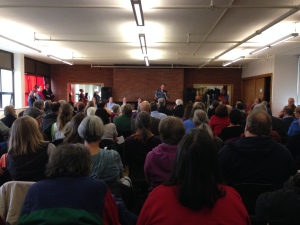Over 150 people packed into an upstairs room of Loyal Heights Community Center yesterday afternoon to share their concerns about the increase of local crime with other community members, officers from the SPD and the Seattle City Council.
The room was jam packed (leaving standing room only) with concerned local residents and business owners keen to get their questions answered in relation to a plethora of concerns ranging from extended police wait times, property theft, SPD staffing cutbacks and more.
The meeting was organized by the newly formed local group Whittier Heights Involved Neighbors (WHIN) and was facilitated by Whittier Heights resident, block captain and WHIN member Gina Frank.
WHIN recently formed in response to the increase of property crime and the decrease in police presence/increased 911 response times in the Whittier Heights area. Last week, Frank stated that the group “hoped to make significant progress during the meeting and aim to work with the SPD and the local community to make Whittier Heights a safer place.”
The room was filled with passionate and concerned locals from all facets of the community looking to find answers about how to make Whittier Heights, and the entire Ballard neighborhood, a safer place.
Members of the SPD including Crime Prevention Coordinator Elizabeth Scott, Community Police Team members Mike Cruzan and Sgt. Dianne Newsom, 911 Communications Section Operations officer Lt. George Bray and Sgt. James Arata were in attendance. City Attorney Liaison Brendan Brophy was also on hand to answer questions.
Mike Stewart, Executive Director of the Ballard Chamber of Commerce and member of the Ballard Partnership for Smart Growth, spoke on behalf of local business owners who have experienced or are concerned about crime.
“The growth of Ballard has happened so quickly that we do not have the public service resources to keep up with it. There is a lack of police presence and the concerns are very real,” says Stewart.
A number of community members in attendance expressed their concerns about the numbers of criminals who actually get caught, what happens to property that has been stolen and what locals can do to assist the SPD in catching criminals. When asked these questions the members of the panel were quick to answer.
Mike Cruzan explained the process of what happens to stolen goods once they are recovered. “We have a warehouse in South Seattle where all the valuables are stored. We attempt to get them back to their owners or also use them as evidence during trials,” says Cruzan.
The panel also emphasized the importance of making our neighborhood “less desirable” by getting to know neighbors, walking the neighborhood together and being aware of and reporting suspicious persons.
Cruzan confirmed that support from the community is helpful however locals sometimes overestimate technology and its usefulness. “Footage or photographs of a crime in progress need to show a clear image of the person’s face in order to identify them,” says Cruzan.
Many locals in attendance also expressed concern about SPD’s lengthy response time to 911 calls. 911 Communications Section Operations officer Lt. George Bray did a comprehensive job of explaining the call triage system to the attendees confirming that SPD officers must first respond to “crimes in progress”.
Bray explained that SPD officers are dispatched using the priority system below:
- Priority 1 – Crimes in progress e.g. shootings, stabbings, domestic violence.
- Priority 2 – Property crimes that have just occurred where the apprehension of the suspect is a possibility.
- Priority 3 – Investigative calls where a crime has previously occurred and SPD officers are dispatched to make a report.
- Priority 4 (rarely used) – Noise complaints with no disturbance to property.
Bray also confirmed that calls are also triaged based on their geographical location within the North Precinct. Bray explained that each of the five precincts within Seattle are also divided into sectors, with the North Precinct being the largest both geographically and by population. The North Precinct is divided into five sectors (Ballard is the “Boy” sector) and each sector has a squad that is assigned to it.
“We keep the squads in each sector intact unless there is a high priority call from another sector. However, Priority 3 calls must be handled by the squad within the specific sector where the crime occurred which is why wait times can be so long,” says Bray.
Bray gave the community the following tips for reducing wait times when reporting a crime:
- Use the Community Online Reporting Program.
- Report the crime outside of “rush periods” such as early in the morning or around midday.
When asked about the staffing levels within the Boy sector at any given time, Sgt. James Arata was unable to give a specific number due to the variances between each shift, however, he confirmed that there are “between three to six or seven officers on patrol in Boy sector at any given time”.
After Sgt. Arata spoke, there was an audible reaction from meeting attendees who were obviously concerned by the number of officers who were on patrol in our area.
“I am disturbed by the amount of crime in our neighborhood. I grew up in NYC and left to get away from this,” said one attendee who received a round of applause for his comment.
In relation to the under-staffing issue, and to questions about opening a SPD sub-station in Ballard, the panel was unanimous in their response.
“I encourage you to pressure your politicians to support law enforcement and provide us with the resources that we need to serve the community. However, I don’t want people to walk away with the understaffing issue as an excuse. Use us, call 911, you pay for it,” says Sgt. Arata.
Sgt. Dianne Newsom also expressed her frustration about the under staffing issue within the SPD. “There isn’t a policeman in this precinct that isn’t frustrated. We want to make it safe for our neighbors,” says Newsom.
Many attendees were interested in what to do next about these issues moving forward, and how we as community members can assist the SPD in preventing crime in the neighborhood. Members of local neighborhood groups Fremont Aurora Wallingford Neighbors (FAWN) and Greenwood Aurora Involved Neighbors (G.A.I.N) were on hand to give their perspective on the importance of neighborhood groups.
“You need to be active and take some steps and remember that is doesn’t happen overnight. It takes a deeply concerted effort, walking the neighborhood, having a newsletter, getting to know your neighbors. When we walked Aurora we didn’t take action, we took notes and gave them to the SPD who helped us,” says a member of FAWN.
Overall, the meeting appeared to ease the concerns of some residents and provided confirmation that WHIN will continue its work to try to reduce crime in the area.
“I am greatly encouraged by the turnout and we definitely have some constructive things to take home,” says Whittier Heights resident Chris Maddock.
Whittier Heights resident, and property crime victim, Karen Noar agreed with Maddock was also encouraged by the meeting. “It is so fantastic to have members of GAIN and FAWN present at the meeting providing their advice and support. I am convinced that we can make it happen here,” says Noar.
WHIN member and meeting organizer Gina Frank was also pleased with the progress made at the meeting. “I think that the meeting went really well. The panel answered with transparency and it is clear that we need to be more political in demanding for more SPD resources,” says Frank.
The lengthy discussion provided many tips for locals to help keep the neighborhood safe and lower crime rates. Check out some tips below:
- If you see something suspicious report it by calling 911.
- Purchase a secure metal, lockable mailbox to prevent mail theft.
- When ordering packages, send them to a location where people will be present to receive them (e.g. your workplace) or use the Amazon Locker service that has several locations in Ballard.
- Do not leave valuables in view when leaving your car.
- Do not walk around at night with your phone out and visible.
- Get to know your neighbors so that it is easier to identify suspicious persons who you do not recognize.
If you are interested in finding out more about the work of WHIN and receive their newsletter email whittierheights@gmail.com. Locals can also join the block watch program and join WHIN if they reside in Whittier Heights.
The My Ballard team will continue to follow the progress of WHIN and inform readers about ways that they can help to reduce crime in our neighborhood.

